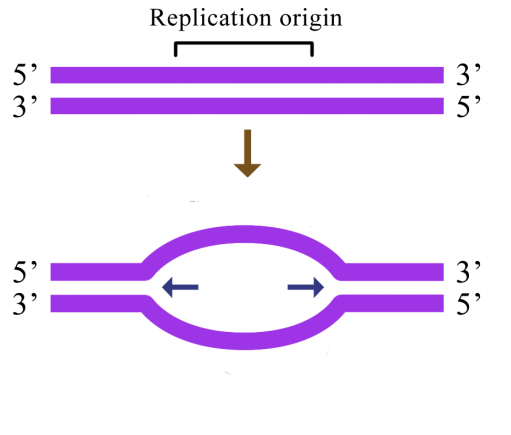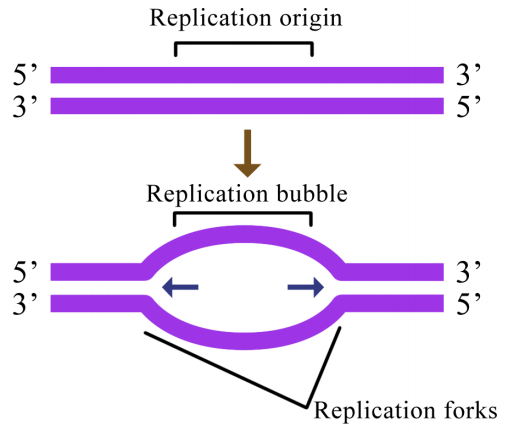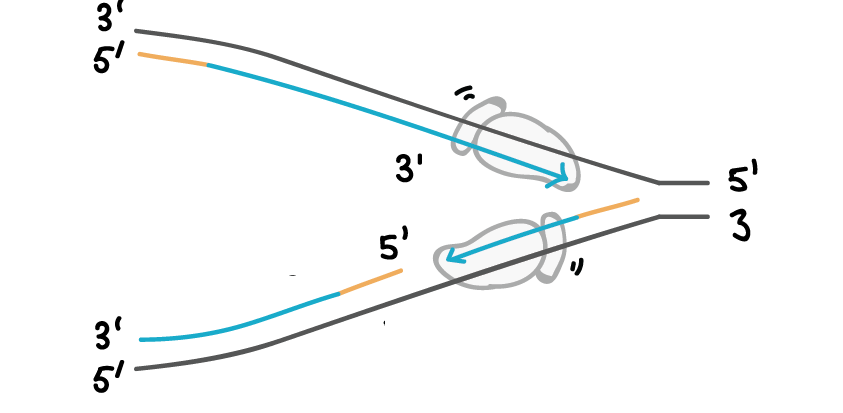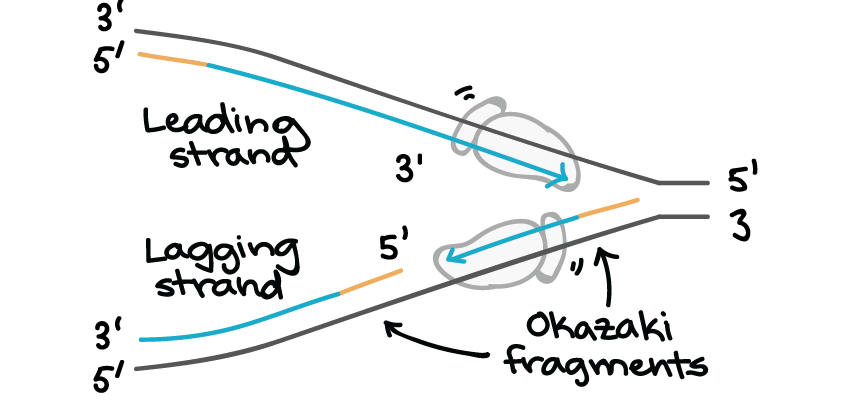Biology 302- Chapter 6: DNA Replication, Repair, and Recombination
5.0(2)
5.0(2)
Card Sorting
1/45
Earn XP
Description and Tags
Study Analytics
Name | Mastery | Learn | Test | Matching | Spaced |
|---|
No study sessions yet.
46 Terms
1
New cards
What is DNA replication?
The accurate duplication of the genetic information carried in its DNA.
2
New cards
What is the point of the complementary nature of the DNA double helix?
It serves as a template for the formation of a new, complementary strand of DNA.
3
New cards
Which of these are synonyms for “replication”?
a. monomerization
b. polymerization
c. bissection
d. synthesis
a. monomerization
b. polymerization
c. bissection
d. synthesis
polymerization; synthesis
4
New cards
The complementary nature of the DNA double-helix allows for the strands to be:
copied precisely
5
New cards
The copying process is carried out with _____ and _____. It takes about ___ hours.
speed and accuracy; 8 hours
6
New cards
What is semiconservative replication?
When each parental strand serves as the template for one new strand. Each daughter DNA double helix is composed of one of the original (old) strands plus one strand that is completely new.
7
New cards
What is the origin of replication?
The ORI is the starting point for DNA replication.
8
New cards
What are replication initiator proteins?
They are proteins that bind to the ORI. They break hydrogen bonds to separate the two original strands of DNA.
9
New cards

Identify the replication bubble and forks in this replication origin.

10
New cards

What are these?
Nucleosomes
11
New cards
Replication forks move away in ______ directions from multiple replication origins in a eukaryotic chromosome.
opposite
12
New cards
The addition of a _______ to the 3’-hydroxyl end of a polynucleotide chain is the fundamental reaction by which DNA is synthesized.
deoxyribonucleotide
13
New cards
A new DNA chain is synthesized in the _______ direction.
5’ to 3’
14
New cards
The enzyme _________ catalyzes the addition of nucleotides to the free 3’ hydroxyl on the growing DNA strand.
a. DNA synthase
b. primase
c. DNA ligase
d. DNA polymerase
a. DNA synthase
b. primase
c. DNA ligase
d. DNA polymerase
DNA polymerase
15
New cards
Whenever DNA polymerase hydrolyzes the phosphodiester bond, it releases energy and makes _______.
pyrophosphate (PPi)
16
New cards
Why are there Okazaki fragments in DNA replication? What strand are they on?
Okazaki fragments are on the lagging strand (thus giving it its name, as making Okazaki fragments is much slower). This is because DNA polymerase can only build in the 5’→3’ direction. The lagging strand starts with the 5’ end, so DNA polymerase must work ‘backwards’ in fragments.
17
New cards

Identify the leading strand and the lagging strand in this photo.

18
New cards
The leading strand is synthesized _________,__ and the lagging strand is synthesized _________.
continuously; discontinuously
19
New cards
What will DNA polymerase do if it accidentally added an incorrect nucleotide?
It will cleave that nucleotide from the strand and replace it with the correct nucleotide. It can do this because DNA polymerase proofreads as it is writing.
20
New cards
\[T/F\] DNA polymerase contains separate sites for DNA synthesis and proofreading.
True
21
New cards
\[T/F\] DNA polymerase can start a new DNA strand with no help.
False. It needs primase to start for it.
22
New cards
What is the enzyme that fills the gaps once the RNA primers are removed?
DNA repair polymerase goes back and fills the gaps.
23
New cards
What is the purpose DNA ligase?
It joins the completed fragments of DNA together by catalyzing the formation of a phosphodiester bond between the 3’-OH end of one fragment and the 5’-phosphate end of the next.
24
New cards
What is the replisome? What are some aspects of it?
The replisome is all the proteins & enzymes needed to allow DNA replication to take place.
\
Some aspects are:
* DNA polymerase
* RNA primers
* Primase
* DNA replicator proteins
* Helicase
* Single-strand DNA binding proteins (SSBPs)
* Nucleases
* Ligase
\
Some aspects are:
* DNA polymerase
* RNA primers
* Primase
* DNA replicator proteins
* Helicase
* Single-strand DNA binding proteins (SSBPs)
* Nucleases
* Ligase
25
New cards
\[T/F\] DNA polymerase can easily stay on the strand by its own.
False. It has a circular protein clamp.
26
New cards
What is DNA helicase?
It separates the strands of the parental DNA double helix so that DNA polymerase and primase can do their jobs.
27
New cards
What are SSBPs?
Single-strand DNA-binding proteins maintain the separated parent strands of DNA as single strands to provide access for the primase and polymerase enzymes.
28
New cards
What do DNA topoisomerases do?
They relieve the stress on the tightly coiled parent strand by placing temporary nicks in the DNA to allow for rapid rotation.
29
New cards
What is the purpose of telomerase?
It adds a series of repeats of a DNA sequence to the 3’ end of the template strand, which then allows the lagging strand to be completed by DNA polymerase. This extends beyond the DNA that is to be copied, to allow for the filling of the gap that the final primase left.
30
New cards
What happens if a human inherits two copies of a mutant β-globin gene?
They display the symptoms of sickle cell anemia.
31
New cards
\[T/F\] As we age, so do our replisomes.
True.
32
New cards
\[T/F\] The chance that a cell will become cancerous stays the same throughout our whole life.
False. The chance that a cell will become cancerous increases greatly with age.
33
New cards
If you bind G-A or C-T, it creates a:
problematic bubble in the DNA strand.
34
New cards
Whenever there is an issue with a newly synthesized DNA strand, the ___ strand should be used as the template to repair it.
old, parent
35
New cards
What are the proteins that correct errors that occur during DNA replication?
a. helicase
b. lagging repair proteins
c. polymerase
d. mismatch repair proteins
a. helicase
b. lagging repair proteins
c. polymerase
d. mismatch repair proteins
mismatch repair proteins
36
New cards
What do mismatch repair proteins do?
They provide a signal for ligase and polymerase and remove the erroneous section of new DNA for the other enzymes to properly synthesize the DNA this time.
37
New cards
\[T/F\] Depurination is the loss of a purine in the DNA strand. It is very uncommon, and often means there’s something wrong with the replisome.
False. Depurination is spontaneous and happens frequently. In the time it took you to read this sentence, about one trillion purine bases have been lost from the DNA in your cells.
38
New cards
\[T/F\] Deamination is the loss of an amino group in cytosine that causes it to change to uracil.
True.
39
New cards
What causes a thymine dimer to form?
Thymine dimers are when two adjacent thymine bases have become covalently bonded to each other. This is caused by UV radiation.
40
New cards
What is "excision”?
Step 1 in DNA repair. The cutting of the new erroneous DNA from the old, correct strand.
41
New cards
What is “resynthesis”?
Step 2 in DNA repair. When the original DNA sequence is restored by a repair DNA polymerase.
42
New cards
What is “ligation”?
Step 3 in DNA repair. It seals the nick from the repaired strand and the rest of the new DNA via ATP hydrolysis to remake the broken phosphodiester bond.
43
New cards
What is NHEJ?
Nonhomologous end-joining. It is the most common means of repairing double-strand breaks in somatic human cells.
44
New cards
What is the “quick and dirty” method of repairing double-strand breaks in DNA?
NHEJ. It is dirty because it loses some nucleotides during the repair process.
45
New cards
What is homologous recombination?
The repair of a double-strand DNA break that has no loss of nucleotides at the repair site.
46
New cards
Give me your best summary of DNA replication:
(SCROLL)
\
DNA replication begins in the S-phase of the cell cycle, during Interphase. DNA starts to separate at the origins of replication (ORIs) via initiator proteins.
\
Once separated, helicase slides in and starts to fully unwind the DNA strand for DNA polymerase to slide in and clamp to both the leading and lagging strands.
\
During this process, DNA topoisomerase creates nicks in the original strands of DNA since helicase is unwinding, spinning, and separating the parent DNA so fast.
\
This creates both the replication bubble and the replication fork in the strand pair. SSBPs keep these strands separated for polymerase and primase to do their jobs. From there, DNA polymerase starts to synthesize a new strand of DNA based on the template of the old strand, working in the 5’→3’ direction.
\
As polymerase makes the new strand, it proofreads its own work, making sure not to make mistakes. If, by chance, there is a mistake, then the DNA repair process starts.
\
On the leading strand, polymerase chugs along replicating the DNA. On the lagging strand, a loop is created and polymerase has to work backward (therefore, slower). Primase places RNA primers along the parent strand so that polymerase can make Okazaki fragments (100-300 nucleotides long).
\
DNA polymerase then removes the RNA primers once it no longer needs them, and repair polymerase comes in to fill the gaps (of nucleotides) the primers left. Then, ligase comes in an fills the gaps in the actual backbone of the DNA structure via ATP hydrolysis, thus binding all the Okazaki fragments together.
\
Then, at the end, telomerase adds a series of repeat DNA at the end of the lagging strand so that polymerase can properly finish the DNA strand. This is because a RNA primer was placed there previously, then removed. If this didn’t happen, then we would have continuously shortening strands of DNA with each replication.
\
Finally, the repair/replace/checking stage. If a mistake was made, there would likely be a noticeable bubble or bend in the DNA. Mismatch repair proteins signal these issues in DNA strands and remove the erroneous strips (step 1). Then, repair polymerase comes in to fix everything (step 2). Once all that is done, ligase comes in to bond the backbone back together (step 3).
\
Once this is complete, the DNA wraps around histone dimers, and forms the “beads-on-a-string” form of chromatin. As the chromatin fiber increases, it now becomes packed nucleosomes via histones. This continues as the chromatin folds into “looped domains”. These “looped domains” pack and pack and pack until they make a fully formed chromosome with a centromere and four telomeres (one at each end to let the cell know it’s fully complete and not in need of repair).
\
DNA replication begins in the S-phase of the cell cycle, during Interphase. DNA starts to separate at the origins of replication (ORIs) via initiator proteins.
\
Once separated, helicase slides in and starts to fully unwind the DNA strand for DNA polymerase to slide in and clamp to both the leading and lagging strands.
\
During this process, DNA topoisomerase creates nicks in the original strands of DNA since helicase is unwinding, spinning, and separating the parent DNA so fast.
\
This creates both the replication bubble and the replication fork in the strand pair. SSBPs keep these strands separated for polymerase and primase to do their jobs. From there, DNA polymerase starts to synthesize a new strand of DNA based on the template of the old strand, working in the 5’→3’ direction.
\
As polymerase makes the new strand, it proofreads its own work, making sure not to make mistakes. If, by chance, there is a mistake, then the DNA repair process starts.
\
On the leading strand, polymerase chugs along replicating the DNA. On the lagging strand, a loop is created and polymerase has to work backward (therefore, slower). Primase places RNA primers along the parent strand so that polymerase can make Okazaki fragments (100-300 nucleotides long).
\
DNA polymerase then removes the RNA primers once it no longer needs them, and repair polymerase comes in to fill the gaps (of nucleotides) the primers left. Then, ligase comes in an fills the gaps in the actual backbone of the DNA structure via ATP hydrolysis, thus binding all the Okazaki fragments together.
\
Then, at the end, telomerase adds a series of repeat DNA at the end of the lagging strand so that polymerase can properly finish the DNA strand. This is because a RNA primer was placed there previously, then removed. If this didn’t happen, then we would have continuously shortening strands of DNA with each replication.
\
Finally, the repair/replace/checking stage. If a mistake was made, there would likely be a noticeable bubble or bend in the DNA. Mismatch repair proteins signal these issues in DNA strands and remove the erroneous strips (step 1). Then, repair polymerase comes in to fix everything (step 2). Once all that is done, ligase comes in to bond the backbone back together (step 3).
\
Once this is complete, the DNA wraps around histone dimers, and forms the “beads-on-a-string” form of chromatin. As the chromatin fiber increases, it now becomes packed nucleosomes via histones. This continues as the chromatin folds into “looped domains”. These “looped domains” pack and pack and pack until they make a fully formed chromosome with a centromere and four telomeres (one at each end to let the cell know it’s fully complete and not in need of repair).